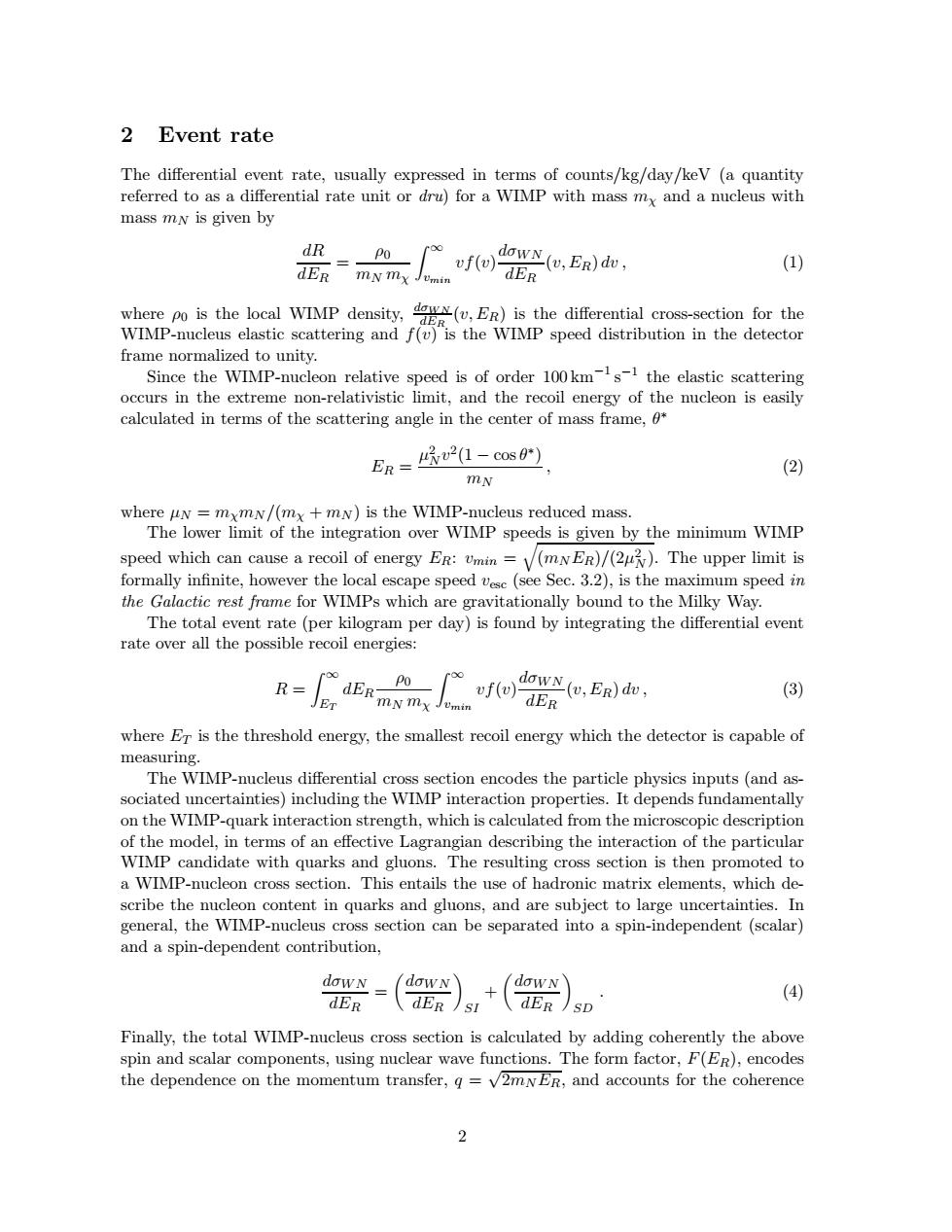正在加载图片...

2 Event rate The differential event rate,usually expressed in terms of counts/kg/day/kev (a quantity referred to as a differential rate unit or dru)for a WIMP with mass mx and a nucleus with mass mN is given by dR =P0 dowN(v,ER)dv, vf(v)dER (1) dER mN mx Jumin where po is the local WIMP density, (v,ER)is the differential cross-section for the ER WIMP-nucleus elastic scattering and f(v)is the WIMP speed distribution in the detector frame normalized to unity. Since the WIMP-nucleon relative speed is of order 100kms-1 the elastic scattering occurs in the extreme non-relativistic limit,and the recoil energy of the nucleon is easily calculated in terms of the scattering angle in the center of mass frame,0* En =2(1-cos0) (2) mN where uN mxmN/(mx+mN)is the WIMP-nucleus reduced mass. The lower limit of the integration over WIMP speeds is given by the minimum WIMP speed which can cause a recoil of energy ER:Umin=V(mN ER)/(2u).The upper limit is formally infinite,however the local escape speed vesc (see Sec.3.2),is the maximum speed in the Galactic rest frame for WIMPs which are gravitationally bound to the Milky Way. The total event rate(per kilogram per day)is found by integrating the differential event rate over all the possible recoil energies: o器e,E (3) mN mx Jvmin where Er is the threshold energy,the smallest recoil energy which the detector is capable of measuring. The WIMP-nucleus differential cross section encodes the particle physics inputs (and as- sociated uncertainties)including the WIMP interaction properties.It depends fundamentally on the WIMP-quark interaction strength,which is calculated from the microscopic description of the model,in terms of an effective Lagrangian describing the interaction of the particular WIMP candidate with quarks and gluons.The resulting cross section is then promoted to a WIMP-nucleon cross section.This entails the use of hadronic matrix elements,which de- scribe the nucleon content in quarks and gluons,and are subject to large uncertainties.In general,the WIMP-nucleus cross section can be separated into a spin-independent(scalar) and a spin-dependent contribution, dowN dowN dowN dER dER (4) SI dER /SD Finally,the total WIMP-nucleus cross section is calculated by adding coherently the above spin and scalar components,using nuclear wave functions.The form factor,F(ER),encodes the dependence on the momentum transfer,q=v2mNER,and accounts for the coherence 22 Event rate The differential event rate, usually expressed in terms of counts/kg/day/keV (a quantity referred to as a differential rate unit or dru) for a WIMP with mass mχ and a nucleus with mass mN is given by dR dER = ρ0 mN mχ Z ∞ vmin vf(v) dσW N dER (v, ER) dv , (1) where ρ0 is the local WIMP density, dσWN dER (v, ER) is the differential cross-section for the WIMP-nucleus elastic scattering and f(v) is the WIMP speed distribution in the detector frame normalized to unity. Since the WIMP-nucleon relative speed is of order 100 km−1 s −1 the elastic scattering occurs in the extreme non-relativistic limit, and the recoil energy of the nucleon is easily calculated in terms of the scattering angle in the center of mass frame, θ ∗ ER = µ 2 N v 2 (1 − cos θ ∗ ) mN , (2) where µN = mχmN /(mχ + mN ) is the WIMP-nucleus reduced mass. The lower limit of the integration over WIMP speeds is given by the minimum WIMP speed which can cause a recoil of energy ER: vmin = q (mN ER)/(2µ 2 N ). The upper limit is formally infinite, however the local escape speed vesc (see Sec. 3.2), is the maximum speed in the Galactic rest frame for WIMPs which are gravitationally bound to the Milky Way. The total event rate (per kilogram per day) is found by integrating the differential event rate over all the possible recoil energies: R = Z ∞ ET dER ρ0 mN mχ Z ∞ vmin vf(v) dσW N dER (v, ER) dv , (3) where ET is the threshold energy, the smallest recoil energy which the detector is capable of measuring. The WIMP-nucleus differential cross section encodes the particle physics inputs (and associated uncertainties) including the WIMP interaction properties. It depends fundamentally on the WIMP-quark interaction strength, which is calculated from the microscopic description of the model, in terms of an effective Lagrangian describing the interaction of the particular WIMP candidate with quarks and gluons. The resulting cross section is then promoted to a WIMP-nucleon cross section. This entails the use of hadronic matrix elements, which describe the nucleon content in quarks and gluons, and are subject to large uncertainties. In general, the WIMP-nucleus cross section can be separated into a spin-independent (scalar) and a spin-dependent contribution, dσW N dER = dσW N dER SI + dσW N dER SD . (4) Finally, the total WIMP-nucleus cross section is calculated by adding coherently the above spin and scalar components, using nuclear wave functions. The form factor, F(ER), encodes the dependence on the momentum transfer, q = √ 2mN ER, and accounts for the coherence 2